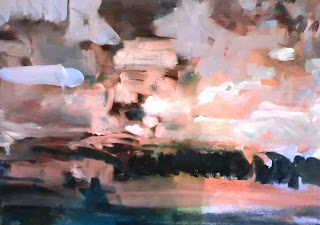
Seeing or "discovering" patterns in nature is the most fundamental practice in the visual arts, especially painting, that seeks to combine nature with one's imagination.

In this Madonna by Raphael, the macchia is meant to convey the essence of the madonna and child, in the foreground, mostly through gesture, but also the landscape elements in the background.
Perhaps there is no better place to practice the art of seeing macchie (pl) than the ocean. The rapidly changing circumstances of sea and rocks provides ample opportunity for new compositions each second.

A landscape:

This exemplifies "Reynold's Riddle" in that "how far can a landscape painter move towards generalization, when the depiction requires representation of the particular location and scene." -- or something to that effect.
As Buddhism states, mostly in its Ch'an manifestation (Zen) as noted in the Platform Sutra, emptiness is the realm of the Dharma. The macchia must have the element of emptiness and spontaneity. That is its conjunction with abstract expressionism as well:

This Eastern point of view combines with Western European ideas of macchia, the notion that grand manner history painting showing individuals and social relationships in the context of landscape:

This very European notion of pastoral beauty and the ideas of Jonathan Richardson the elder regarding composition are important to landscape painters. But the "undifferentiated aesthetic continuum" is the more powerful idea, more deeply articulated in the East by Buddhists and Taoists and picked up by the impressionists, that provides the big idea behind paintings that sing of light, life, and natural surroundings.

Perhaps as one gets older one wants to pull more into this "emptiness" of the Dharma and "pure realm" in the Taoist sense, that is into the vast realms of the poetics of nature. The Tao is always depicted as dark and feminine and mysterious in the East:

While in the West, this is usually flip flopped with scenes of light-filled warmth symbolizing the goodness and sensuous aspects of nature:

This is the "valley spirit" of the Taoists but with the lights turned on. The floating clouds symbolize impermenance and the valley and its warm grasses are the feminine aspect of things, the receptive.
No comments:
Post a Comment